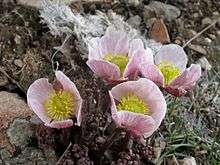Ranunculus andersonii
Ranunculus andersonii is a species of buttercup known by the common name Anderson's buttercup.[1] It is native to the western United States, including the Great Basin and surrounding regions, where it grows in sagebrush, woodlands, and other habitat. It is a perennial herb producing a basal rosette of thick leaves which are each divided into three double-lobed leaflets at the end of a petiole. The inflorescence arises from the rosette on an erect, leafless stalk usually no more than 20 centimeters tall. It bears one flower with usually five white or red-tinged petals each up to 2 centimeters long with white or pinkish sepals at the base. At the center of the flower are many yellow stamens and pistils. The fruit is an achene, borne in a spherical cluster of 14 or more. It was named after Charles Lewis Anderson by Asa Gray[2].
| Ranunculus andersonii | |
|---|---|
 | |
| Scientific classification | |
| Kingdom: | Plantae |
| Clade: | Tracheophytes |
| Clade: | Angiosperms |
| Clade: | Eudicots |
| Order: | Ranunculales |
| Family: | Ranunculaceae |
| Genus: | Ranunculus |
| Species: | R. andersonii |
| Binomial name | |
| Ranunculus andersonii | |
References
- "Ranunculus andersonii". Natural Resources Conservation Service PLANTS Database. USDA. Retrieved 18 October 2015.
- Gray, Asa (1868). "Characters of New Plants of California and Elsewhere . . ". Proc. Amer. Acad. Arts. 7: 327. Retrieved Mar 7, 2020.
